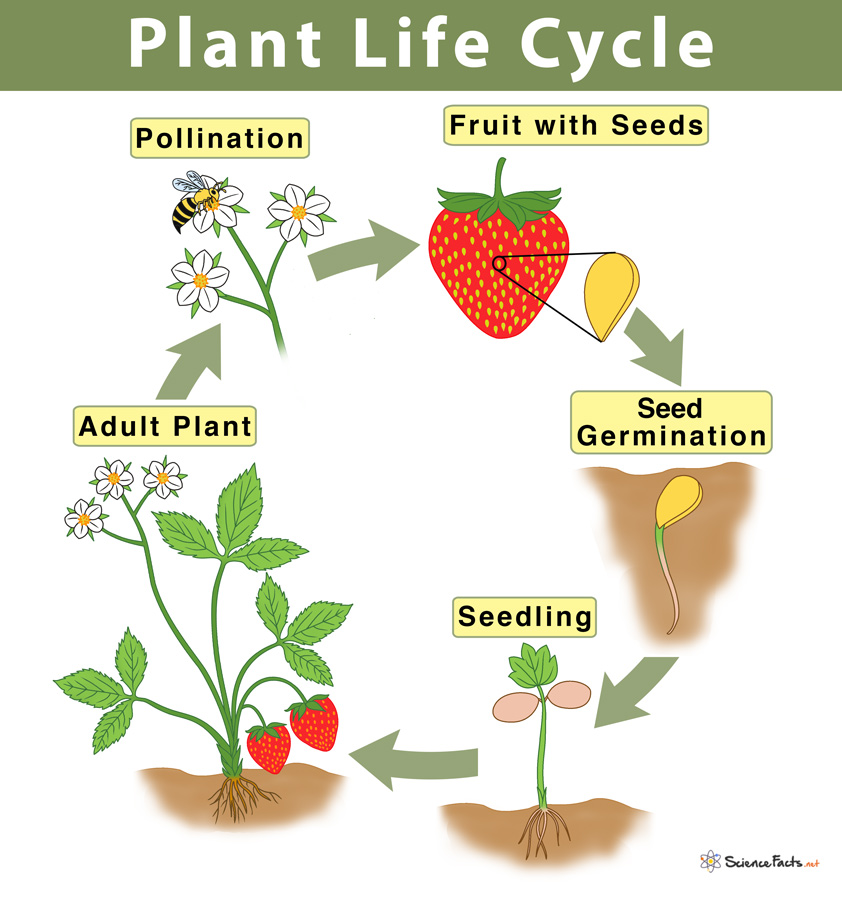Plant Life Cycle
What is the Life Cycle of a Plant
Plants are living things that grow and reproduce, similar to all other living organisms on earth. The plant life cycle describes the stages that the plant goes through from its birth until its death. They are found in all types of plants; flowering or non-flowering and vascular or nonvascular.
In flowering plants, the process starts with seed formation, which then germinates to give rise to a new plant. The young plant gradually matures to form an adult plant, which eventually dies to repeat the cycle. Rose, sunflower, jasmine, lily, rice, tomato, cucumber, peanut, and sweet potato are typical flowering plants.
Stages of Life Cycle in Flowering Plants
A basic plant life cycle goes through five stages: 1) seed, 2) seed germination, 3) seedling, 4) adult plant, and 5) pollination and fertilization. They are discussed below in detail.
1) Seed
The life cycle of a flowering plant begins with a seed. It has a protective outer covering called the shell. Inside the shell contains the baby plant or the developing embryo and the endosperm that contains reserve food. The endosperm nourishes the embryo with necessary food and water during its development.
Seeds are dispersed or spread in various ways. Some are blown by the wind, while others float on water. Birds, bees, insects, and animals also act as agents of seed dispersal. Some are eaten by animals and are spread through their wastes. Humans sow seeds for various purposes, such as in agriculture or gardens for decorative purposes.
2) Seed Germination
Next, the planted seeds germinate, forming a seedling. The four key environmental factors necessary for seed germination are oxygen, water, sunlight, and appropriate growth temperature. When all these four factors are ideal, the seeds sprout to form a seedling. Initially, the root pushes its way through the seed coat and starts growing downwards into the soil. Subsequently, the first leaf appears.
3) Seedling
After successful germination, a delicate, young plant called the seedling starts making its way out of the ground towards sunlight. As it grows, the seedling derives all its essential nutrients from the soil through its roots.
The growing plant traps sunlight with the help of a pigment called chlorophyll. These pigments, which are found in their leaves, make food for the plant using sunlight, carbon dioxide, and water through photosynthesis.
4) Adult Plant
The process of photosynthesis allows the young, developing plant to grow into an adult plant gradually. A fully mature plant consists of roots, stems, and leaves. The roots derive nutrients and water from the soil, while the stem carries them to the leaves. The leaves perform photosynthesis to prepare food in the form of carbohydrates.
In a flowering plant, the flower is the reproductive organ. It consists of four different parts: sepals, petals, stamens, and carpels. Stamen is the male reproductive part that consists of anther and filament. At the same time, the carpel is made of stigma, style, and ovary. They together form the female reproductive part.
The stamen produces pollen, a small, powdery substance that contains half the genetic material of a new plant. On the other hand, the stigma has the other half of the genetic material that receives the pollen. It contains the ovules, which later becomes the seed after the pollen fertilizes it.
5) Pollination
A fully mature flowering plant now participates in reproduction, which occurs by pollination.
Pollination is when pollens are picked from the anther of a flower and transferred to the stigma of the same or different flower. Various pollinating agents, such as bees, butterflies, insects, birds, and animals, including humans, perform pollination. When the pollen grains reach the ovule of a plant, they are fertilized to become seeds.
The newly produced seeds repeat the same life cycle to generate new plants similar to the parent.
Life Cycle of Non-flowering Plants
Nonvascular plants such as algae, ferns, mosses, and liverworts do not produce flowers and seeds and are also known as non-flowering plants. They reproduce through spores of their parent plant. Spores are an asexual form of reproduction and thus do not require a mate for their production.
A spore is typically a single cell with a thick cell wall. Once a spore is formed, it is immediately released by the plants into the environment. The process of spore formation in plants is called sporogenesis. Under proper environmental conditions, the spores go through a series of developmental stages to form a new plant.
FAQs
Ans. Each group of plants, whether they are flowering or non-flowering plants, has its specific life cycle. However, all life cycles are the same in that they begin with birth and end with the death of a plant. Each plant’s lifecycle alternates between two phases: the diploid (2n) and the haploid (n) phase.
Ans. The life cycle of seedless, vascular land plants involves altering generation. The diploid sporophyte stage alternates with the haploid gametophyte stage. While the diploid phase is the dominant phase in their life cycle, the haploid phase is inconspicuous.
-
References
Article was last reviewed on Thursday, February 4, 2021




